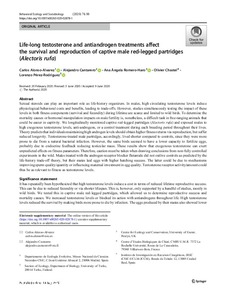Life-long testosterone and antiandrogen treatments affect the survival and reproduction of captive male red-legged partridges (Alectoris rufa)
Alonso-Alvarez Carlos; Cantarero Alejandro; Romero-Haro Ana Ángela; Chastel Olivier; Pérez-Rodríguez Lorenzo
https://urn.fi/URN:NBN:fi-fe2021042821298
Tiivistelmä
Sexual steroids can play an important role as life-history organizers.
In males, high circulating testosterone levels induce
physiological/behavioral costs and benefits, leading to trade-offs.
However, studies simultaneously testing the impact of these levels in
both fitness components (survival and fecundity) during lifetime are
scarce and limited to wild birds. To determine the mortality causes or
hormonal manipulation impacts on male fertility is, nonetheless, a
difficult task in free-ranging animals that could be easier in
captivity. We longitudinally monitored captive red-legged partridges (Alectoris rufa)
and exposed males to high exogenous testosterone levels,
anti-androgens, or a control treatment during each breeding period
throughout their lives. Theory predicts that individuals maintaining
high androgen levels should obtain higher fitness returns via
reproduction, but suffer reduced longevity. Testosterone-treated male
partridges, accordingly, lived shorter compared to controls, since they
were more prone to die from a natural bacterial infection. However, the
same birds seemed to have a lower capacity to fertilize eggs, probably
due to endocrine feedback reducing testicular mass. These results show
that exogenous testosterone can exert unpredicted effects on fitness
parameters. Therefore, caution must be taken when drawing conclusions
from non-fully controlled experiments in the wild. Males treated with
the androgen-receptor blocker flutamide did not outlive controls as
predicted by the life-history trade-off theory, but their mates laid
eggs with higher hatching success. The latter could be due to mechanisms
improving sperm quality/quantity or influencing maternal investment in
egg quality. Testosterone receptor activity/amount could thus be as
relevant to fitness as testosterone levels.
Kokoelmat
- Rinnakkaistallenteet [27094]
